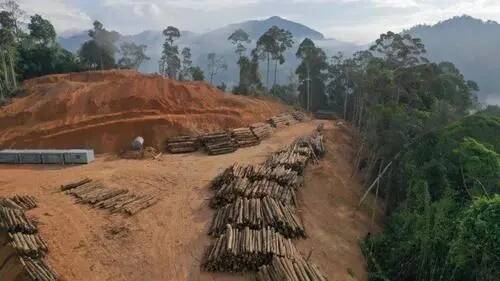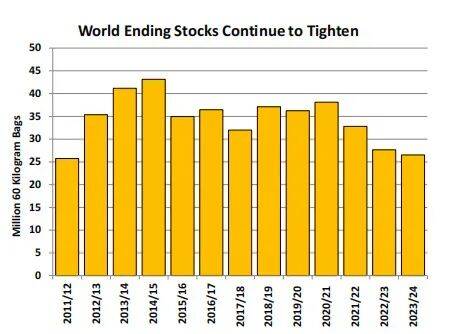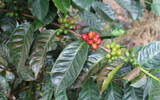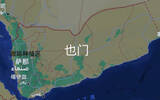The United States Department of Agriculture has released a report on Coffee: global Markets and Trade, predicting future coffee production
Towards the end of the year, many coffee importers and coffee producing countries released their 2023 annual reports. It is pointed out in several reports that the war between Russia and Ukraine and the Israeli-Palestinian conflict this year have reduced consumption in some areas, and inflation has also led to a reduction in consumption. This year's relatively high interest rates have increased the cost of trade, and the EU's deforestation regulations (EUDR) will increase the cost of 2024 coffee trade.

In terms of weather, El Ni ñ o was originally expected to end in the first quarter, but it will be extended, and it is not expected to end until the second quarter of 2024, which has a significant impact on many coffee producing countries that are in the equator and bloom in April-May. And it has had a lot of impact on the Robusta producing areas of coffee-producing countries, especially in Brazil, leading to a rise in the price of robusta coffee beans.
Recently, the United States Department of Agriculture (USDA) released the report "Coffee: global Market and Trade". According to the report, global coffee production is expected to be 171.4 million bags by the end of 2023 / 24, an increase of 6.9 million bags over the previous year. Global production is mainly in Brazil, Colombia and Ethiopia, offsetting Indonesia's production cuts. Global coffee bean exports are expected to be 119.9 million bags, also an increase of 8.4 million bags over the previous year. With global coffee consumption expected to reach a record 169.5 million bags, ending inventory remains at a 12-year low of 26.5 million bags.

Brazil, which was affected by drought and other bad weather earlier, is now returning to its previous level. A total of 66.3 million bags of coffee are expected to be produced in 2023 to 24, an increase of 3.7 million bags over the previous year. Of this total, Arabica coffee production increased by 5.1 million to 44.9 million bags, while Robusta coffee production will be reduced by 1.4 million to 21.4 million bags. Coffee bean exports are expected to increase by 7.3 million bags to 39.5 million bags.
Colombian production is recovering, so the premium has fallen. Coffee production is expected to increase by 800000 bags to 11.5 million bags in 2023 to 24. However, due to the sharp rise in fertilizer prices, Colombian coffee production is 15% lower than its production potential. Exports are expected to increase by 1.2 million bags to 10.8 million bags.
Vietnam's coffee production in 2024 is a mystery, depending on two important time points: January and April. Production is expected to increase by 300000 bags to 27.5 million bags in 2023 to 24, and 95 per cent is still Robusta. Due to the depletion of reduced production stocks in the previous year, some of them will be used to cover inventories this year, and exports are expected to fall by 2.4 million to 23 million bags.
The El Ni ñ o phenomenon in Indonesia will damage Indonesia's coffee production in 2023 and 2004. Production is expected to decrease by 2.2 million bags to 9.7 million bags in 2023 to 24. Of this total, Robusta production decreased by 2.1 million to 8.4 million bags, and Arabica coffee production decreased by 100000 to 1.3 million bags. Exports also decreased by 2.7 million bags to 5 million bags.
Note: 60kg per bag
Important Notice :
前街咖啡 FrontStreet Coffee has moved to new addredd:
FrontStreet Coffee Address: 315,Donghua East Road,GuangZhou
Tel:020 38364473
- Prev

Introduction to the Development History, varieties, Gold Standard and Red Standard of Rosa Village in Ethiopia
Rose varieties were first collected from the coffee forests of Ethiopia in the 1930s. From there it was sent to the Lyamungu Research Station in Tanzania and then taken to Centro Agron ó mico Tropical de in Costa Rica in 1953.
- Next

Introduction of coffee development, coffee producing areas and coffee varieties in Yemen in Asian countries
Yemen is located in the southwestern tip of the Arabian Peninsula, neighboring Saudi Arabia and the Sultanate of Oman, facing Ethiopia and Somalia across the Strait of Mande to the west, and bordering the Red Sea, the Gulf of Aden and the Arabian Sea. The climate in the mountains and plateaus is mild, the desert is hot and dry, and the annual average maximum temperature is 39 ℃.
Related
- What ratio of water temperature and ground does the smart cup method use to press coffee? The difference between brewed coffee and filtered coffee?
- What is the standard process for the purpose of coffee cup testing? What is the difference between hand-brewed coffee and cup testing?
- How to use hand-brewed coffee paragon small golden balls? How does cold coffee lock in the aroma of coffee?
- Is American coffee black? What is the difference between American coffee and drip coffee?
- Unexpected! Well-known tea beverage brand Lele Tea will withdraw from the Zhengzhou market!
- Starbucks enters the fashion and beauty industry?! Netizen: Give me an ice American eye cream
- Why can American refills for free? The difference between Americano and American drip pot coffee
- Being chased out of the rain in front of Starbucks?! Store: Sheltering from rain under umbrellas poses a safety hazard
- The white moonlight has changed?! Lucky launches "Big Winter Pear American"
- Hand-brewed coffee three-stage method, high-sweet and universal brewing method to share! What does the high sweet water level of hand-brewed coffee mean?

